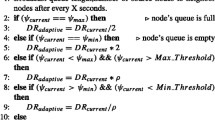Abstract
Due to complicated situations such as node/link interference and traffic load, quality of service support in multi-hop multi-rate ad hoc networks remains a challenging issue. Furthermore, when mobility is present, because of frequent route change, it is even more difficult to maintain high level performance for existing real-time flows that may not tolerate serious performance degradation. In this paper, we focus on the issue of providing sufficient QoS in networks with moderate to high node mobility. We first introduce route available bandwidth (RAB), a major index for prediction of flow performance along a specific path. RAB considers various important factors such as intra-flow interference, effective link bandwidth, and channel busy time. Then, we devise a DSR based admission control scheme where the source node accepts/rejects a flow according to the RAB of the collected route when it receives a route reply packet. To handle mobility, we incorporate an additional metric of route reliability (RR) so that a path with sufficient bandwidth and reliability can be obtained. Results show that with admission control, existing flows experiences around 80–95% average delivery ratio, even for 20 m/s maximum moving speed, which is much better than 30–60% average delivery ratio when admission control is absent.


















Similar content being viewed by others
References
Awerbuch, B., Holmer, D., & Rubens, H. (2004). High throughput route selection in multi-rate ad hoc wireless networks. In Proceedings of WONS’04, Madonna di Campiglio, Italy, January 2004.
Barry, M., Campell, A. T., & Veres, A. (2001). Distributed control algorithms for service differentiation in wireless packet networks. In Proceedings of IEEE INFOCOM 2001.
Chen, L., & Heinzelman, W. (2005). QoS-aware routing based on bandwidth estimation for mobile ad hoc networks. IEEE Journal on Selected Areas of Communication, 23(3), 561–572.
Clausen, T., & Jacquet, P. Optimized link state routing protocol (OLSR). RFC 3626. Available at: http://www.ietf.org/rfc/rfc3626.txt
Draves, R., Padhye, J., & Zill, B. (2004). Routing in multi-radio, multi-hop wireless mesh networks. In Proceedings of ACM MobiCom 2004, Philadelphia, PA.
Dube, R., Rais, C., Wang, K., & Tripathi, S. (1997). Signal stability based adaptive routing (SSA) for Ad-hoc mobile networks. IEEE Personal Communications, 4, 36–45.
Goff, T., Abu-Ghazaleh, N. B., Phatak, D. S., & Kahvecioglu, R. (2001). Preemptive routing in ad hoc networks. In Proceedings of ACM MobiCom 2001.
Holland, G., Vaidya, N., & Bahl, P. (2001). A rate-adaptive MAC protocol for multi-hop wireless networks. In Proceedings of ACM MOBICOM’01, Rome, Italy.
Johnson, D. B., Maltz, D. A., & Broch, J. (2001). DSR: The dynamic source routing protocol for multi-hop wireless ad hoc networks. In C. E. Perkins (Ed.), Ad hoc networking (pp. 139–172). Reading, MA: Addison-Wesley.
Kazantzidis, M., Gerla, M., & Lee, S.-J. (2001). Permissible throughput network feedback for adaptive multimedia in AODV MANETs. In IEEE International Conference on Communications (ICC’01), Vol. 5, pp. 1352–1356, June 11–14, 2001.
Li, J., Blake, C., De Couto, D. S. J., Lee, H. I., & Morris, R. (2001). Capacity of ad hoc wireless networks. In ACM MobiCom’01, pp. 61–69.
Li, M., & Prabhakaran, B. (2005). Route available bandwidth based QoS strategy in multi-hop multi-rate mobile ad hoc networks. Technical report, No. UTDCS-31-05, Aug. 2005.
Li, M., Prabhakaran, B., & Ramesh, S. (2004). Modeling interference in IEEE 802.11 wireless ad hoc networks. Technical report, University of Texas at Dallas, Sept. 2004.
Li, Z., Nandi, S., & Gupta, A. K. (2004). Improving MAC performance in wireless ad hoc networks using enhanced carrier sensing (ECS). In Proceedings of NETWORKING 2004, pp. 600–612.
Medidi, S. R., & Vik, K.-H. (2004). Quality of service-aware source-initiated ad-hoc routing. In Proceedings of IEEE SECON’04.
Perkins, C. E., & Bhagwat, P. (1994). Highly dynamic destination sequenced distance vector routing (DSDV) for mobile computers. In Proceedings of ACM SIGCOMM, Oct. 1994
Perkins, C. E., Belding-Royer, E. M., & Chakeres, I. (2003). Ad hoc on demand distance vector (AODV) routing. In IETF internet draft, draft-perkins-manet-aodvbis-00.txt, Oct 2003 (Work in Progress).
Sadeghi, B., Kanodia, V., Sabharwal, A., & Knightly, E. (2002). Opportunistic media access for multi-rate ad hoc networks. In Proceedings of ACM Mobicom’02, Atlanta, Georgia.
Sanzgiri, K., Chakeres, I. D., & Belding-Royer, E. M. (2004). Determining intra-flow contention along multihop paths in wireless networks. In Proceedings of broadnets 2004 wireless networking symposium, San Jose, CA.
Shah, S. H., Chen, K., & Nahrstedt, K. (2003). Available bandwidth estimation in IEEE 802.11-based wireless networks. In Proceedings of Best’03.
Sriram, S., Bheemarjuna Reddy, T., Manoj, B. S., & Siva Ram Murthy, C. (2005) On the end-to-end call acceptance and the possibility of deterministic QoS guarantees in ad hoc wireless networks. In Proceedings of ACM MobiHoc’05, May 2005.
Yang, Y., & Kravets, R. (2004). Contention-aware admission control for ad hoc networks. UIUCDCS-R-2003-2337, May 2004.
Xue, Q., & Ganz, A. (2003). Ad hoc QoS on-demand routing (AQOR) in mobile ad hoc networks. Journal of Parallel Distributed Computing, 63, 154–165.
IEEE. (1997). IEEE std 802.11 – wireless LAN medium access control (MAC) and physical layer (PHY) specification.
OAR implementation, Rice network group. Available at: http://www.ece.rice.edu/networks/software/OAR/OAR.html.
Preemptive routing implementation. Available at: http://www.csee.umbc.edu/~phatak/sw/preemptive/index.html.
Acknowledgment
The work is supported in part by US Army Research Office grant 48645-MA and NSF under Grant No. 0237954 for the project CAREER: Animation Databases. An early version of this paper appears in the First IEEE International Workshop on Next Generation Wireless Networks 2005 (IEEE WoNGeN ‘05). We would like to thank the anonymous reviewers for their valuable suggestion that have significantly improved the quality of this paper.
Author information
Authors and Affiliations
Corresponding author
Rights and permissions
About this article
Cite this article
Li, M., Prabhakaran, B. On supporting reliable QoS in multi-hop multi-rate mobile ad hoc networks. Wireless Netw 16, 813–827 (2010). https://doi.org/10.1007/s11276-009-0170-5
Published:
Issue Date:
DOI: https://doi.org/10.1007/s11276-009-0170-5




